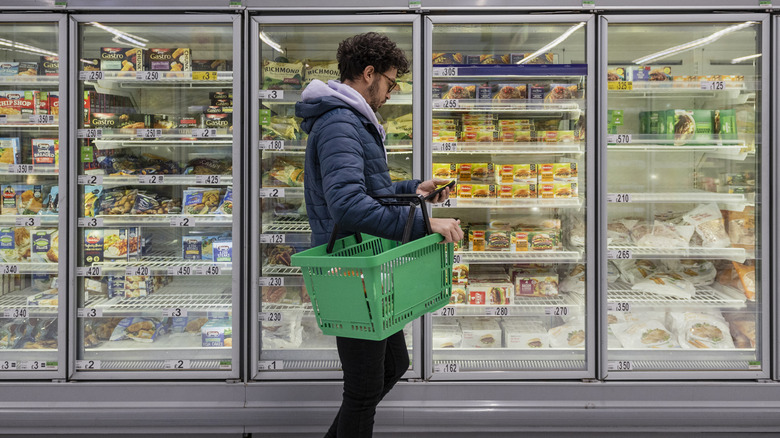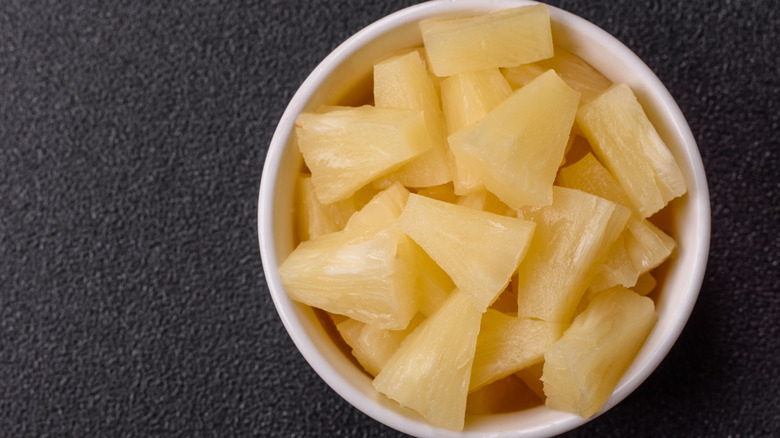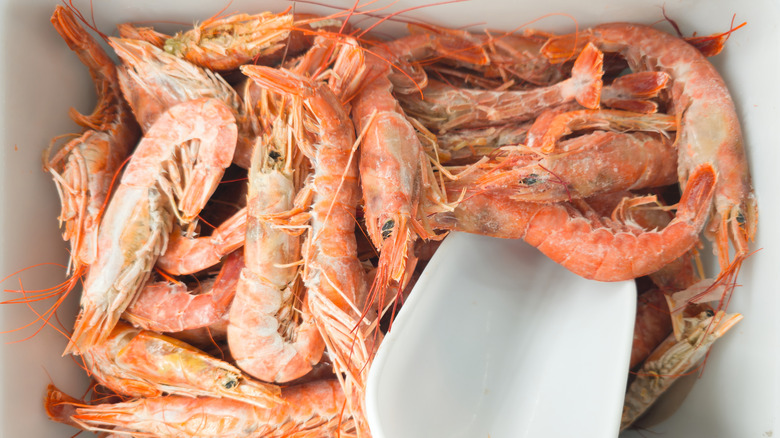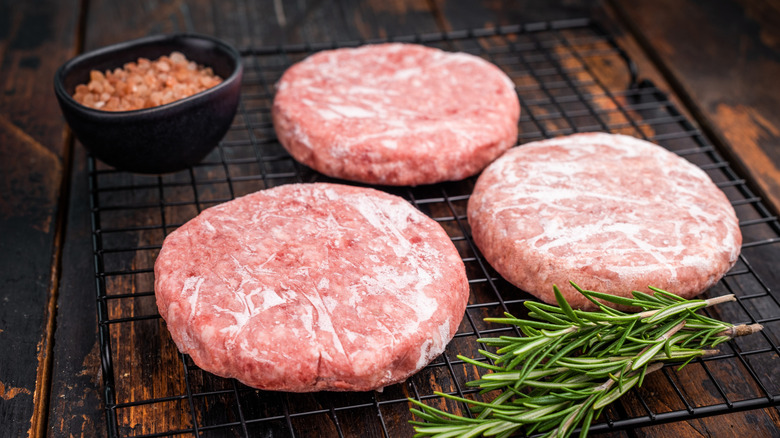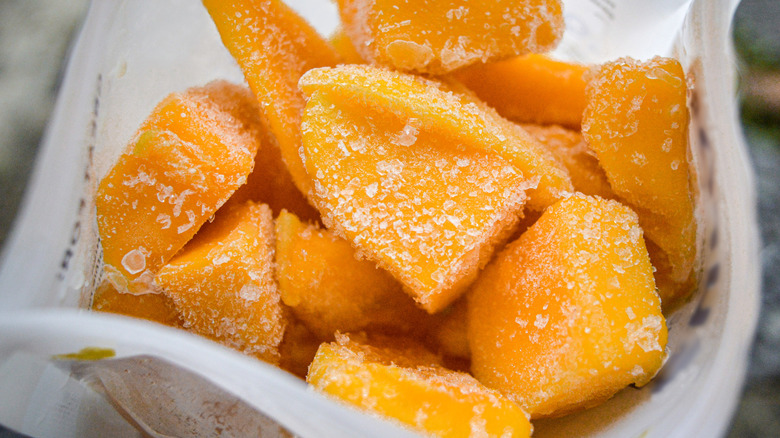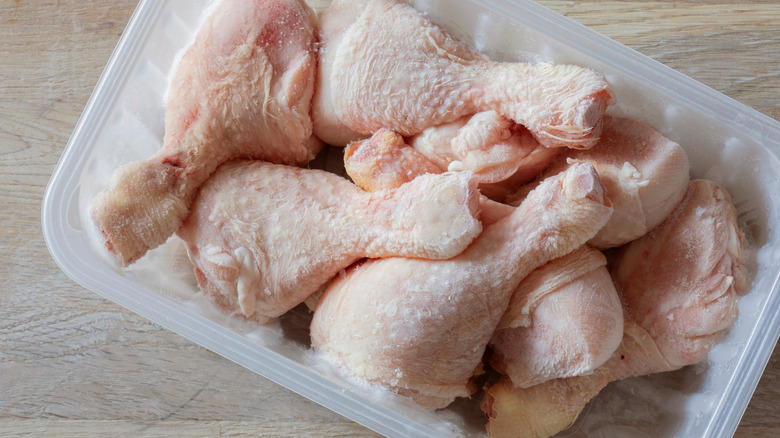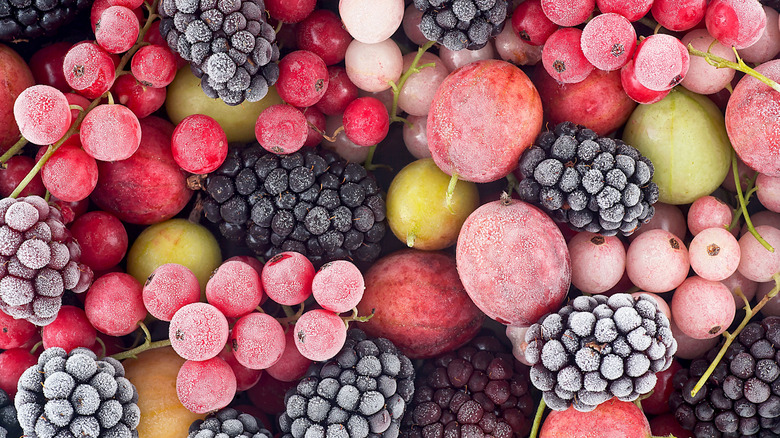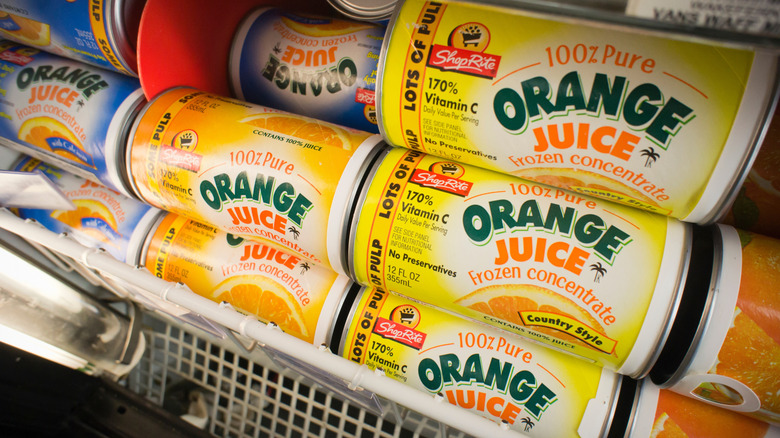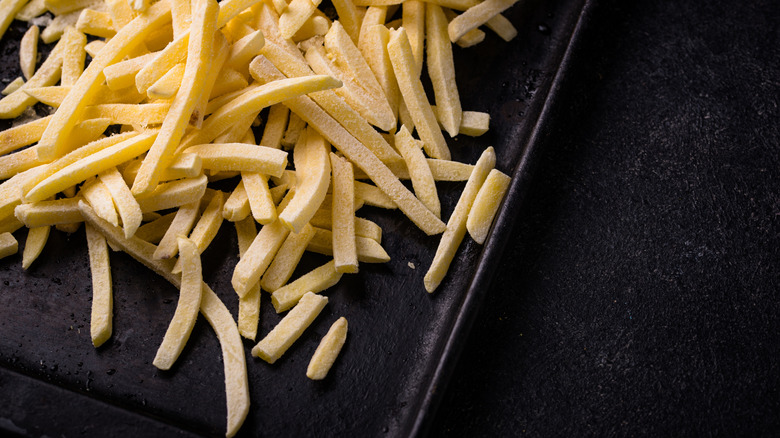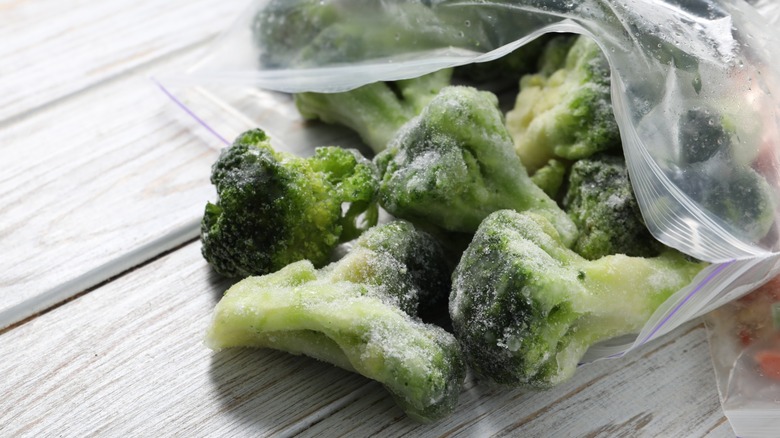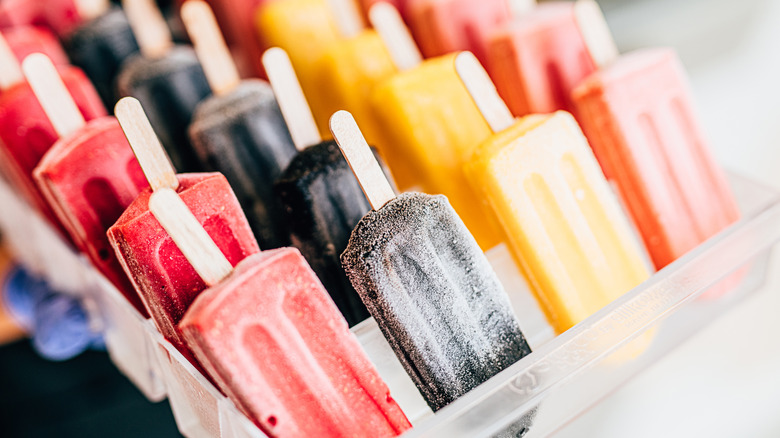Stock Up Now: 10 Frozen Foods That Are About To Get More Expensive
Predictions about how the coming tariff wars will impact everyone's grocery bill have run the gamut from no noticeable impact to upwards of doubling prices of certain items, depending on the product and the region from which the U.S. imports it. One of the grocery store sections due to see a wide range of price increases is the frozen food aisle, a microcosm of the entire grocery world in cold storage. Just about every other food in the store can be found somewhere in the freezer section, from fruits and vegetables to meats and pasta. This representation makes it easy to keep convenient meals and ingredients on hand, but also increases the risk of additional grocery cost for everyone.
Which frozen foods in particular are bound to become more expensive? Similar to canned foods you should stock up on to avoid shelling out more money than you need to, there are several frozen foods you should think about doubling up on while costs are potentially as low as they'll be for a while. It's worth clearing out a little space in your freezer or even investing in that deep freezer you've been thinking about to hold your extra wares ... before the price of that handy little appliance goes up, too. Whether you watch your usual stores for sales and specials or grab some Costco products to bulk up your wares, here are some of the most vulnerable frozen foods on the bubble for a tariff-produced price rise.
1. Pineapple
It isn't only fresh and canned pineapple that will be feeling the pinch when the tariffs finally kick in; frozen pineapple is just as vulnerable to the additional costs as its warm-storage counterparts. In addition to bags of frozen pineapple chunks that you may keep on hand to use in your smoothies, bear in mind that pineapple also appears as a featured ingredient in some frozen Asian meals. The additional expense to food producers who use pineapple even in small amounts is likely to be passed on to consumers, even if it means a smaller hike than an unadulterated pineapple product. Even domestic grower Dole is raising its prices as part of the hullabaloo. With the U.S. importing pineapples from Costa Rica, Guatemala, and Peru — all facing a 10% tariff — you'll soon be digging deeper in your pocket for pineapple-heavy items.
Before you eat another frozen pineapple product destined to become more expensive in the coming months, you should know that fresh and canned pineapple store in the freezer as well as bagged and frozen pineapple. Simply remove them from the can and toss them in a zip-close bag, then squeeze out the air and lay them flat to maximize room in your freezer. But if you're quick enough, you should still be able to get a few bags of the usual flash-frozen pineapple at the prices you're used to paying. You also have time to zero in on the frozen meals that use pineapple and pick up extras of those, too.
2. Seafood
Say farewell to affordability in your love affair with frozen seafood once the tariffs take effect; everything from bags of shrimp and wheels of shrimp cocktail to frozen fish fillets and fish sticks will potentially experience price increases as part of the rollout. The uncertainty could knock your weeknight shrimp recipes to the bottom of the menu if costs get too precious to pay. Shrimp alone faces tariff increases ranging from 10% to 46%, depending on the region; fish coming from Asian countries could see anywhere from 32% for Indonesian imports to 36% for Cambodian products to 46% for Vietnamese stock.
Naturally, you should pick up extras of your favorite packaged frozen fish to prepare for them becoming more expensive. But you also have the opportunity to buy from local fisherman who might be in need of a boost in business. You'll get fresher product while sharing your funds with neighborhood business folk, perfect for keeping ahead of the frozen fish freeze-out that's bound to school pescatarians on the perils of trade wars with global seafood suppliers. And if you happen to be a fishing hobbyist, of course catching and freezing your own is always a fantastic strategy.
3. Beef
If you think most of the beef you find in the freezer section of the grocery store you love to shop in is American-raised, think again. Unless you can ascertain that those frozen steaks and burgers come from domestic ranches, you may be dining on beef from Canada and Mexico, which puts them squarely in the bull's-eye as a tariff-vulnerable victim within the frozen food sector. With forces like higher grain prices and inflation already driving up the cost of beef, an added tariff is bound to cause a bit of indigestion when you roll your cart to the register.
No need to give up on crafting the perfect burger just because prices are set to take a bump. Buying additional beef products on sale makes the most sense for getting your frozen foods supply good and ready for the upcoming price shift. But if you live in a rural area and have access to fresh beef, consider ordering cuts ahead of time and filling up your freezer with locally-farmed and ranched meats, too. You may even discover producers in your community in need of support who can accommodate your needs with more dependability than the forthcoming tariff-generated pricing structure can offer.
4. Mango
The lush freshness of frozen mango is on the chopping block thanks to the U.S.'s dependence on Mexico and South America for this semi exotic fruit. Once this luscious produce gets more expensive, you can expect to see prices for frozen chunks from most brands grow faster than a mango tree in the tropics. This will impact big names like Dole and Goya as well as store-label names like Target's Good & Gather and Walmart's Great Value, as most mangoes in the country are hauled in from Mexico (facing a 25% tariff), with smaller quantities coming from Brazil, Peru, Ecuador, and Guatemala, all going up against an additional 10% tariff. Once the boom is lowered, it'll be impossible to make a mango smoothie or margarita without feeling the squeeze.
Though you can easily buy additional bags of mango if you see it at the grocery store, you can also pick up fresh mangoes in the produce section to give your frozen treasures additional provisions. If you happen to see actual mangoes stacked among the apples and oranges, grab a few to make your own fruit-based freezer feast. Peel, slice, and wrap the fruit in plastic wrap and store it in zip-close bags to maintain quality. And of course, canned and jarred mango can be transferred to storage bags and kept in the freezer to ensure a plentiful frozen harvest.
5. Chicken
It wouldn't seem like you would have to go too far outside of the U.S. to package chicken for frozen meals, as prevalent as chicken farms seem to be in the states. But as part of greater trade in tips and agreements, America receives a fair quantity of chicken stock from Canada and Chile. Obviously, this means that if you're a fan of frozen chicken strips, nuggets, potpies, or any of the other forms in which chicken may appear, you'd be wise to plan a big shop now. The elevated costs for these imports winging their way to the grocery world are bound to make you fly the coop when you troll the freezer section for your favorite chicken items.
Though fresh chicken may be your go-to ingredient for healthy, protein-packed dinners, consider packing some of the fresh finds at your favorite grocer when they go on sale and creating your own frozen collection of parts you know you'll need. Of course, nuggets and strips are a must for your icebox, especially if you anticipate needing a store of these specialty items for easy suppers and special gatherings where bar bites are the preferred menu. Increasing your supply may seem a little costly now, but it beats being caught on your back foot when and if the tariff-related increases take effect.
6. Berries
Strawberries are one of the most visible representatives of the terrible tariff turn-about, as most of these heart-shaped fruits are delivered to the U.S. from our neighbor to the south, Mexico. But other berries including blackberries and raspberries also come from parts beyond our continuous borders, which means you'll be seeing prices of bagged frozen berries jacked up when tariffs assert their influence over the pricing structure of frozen foods. It's unfortunate, considering frozen berries capture more of the fruit's powerful nutrients longer than even fresh berries can, thanks to the flash-freezing method that locks the goodness in place. When costs start climbing, all the nourishment could zero out your shopping budget before you even make it out of the freezer section.
Purchasing extra bags of frozen berries is the most obvious way to prepare for whatever might be coming down the road in the post-tariff world. But consider picking up fresh berries from a nearby farmers market or your favorite grocery store as the season ramps up and freeze them yourself. You'll be supporting your local economy and potentially showing love to small businesses and regional growers while shoring up your frozen berry supplies in the process.
7. Fruit juices
If you're a fan of frozen fruit juice concentrates, you may have noticed prices have been rising over the past five years. Even a can of the best store-bought orange juice mix has soared from just about a dollar to nearly $3, thanks in part to climate-influenced inflation. Expect this trend to continue when tariffs are finally in play, thanks to the sources of much of the citrus juice that makes it into the can. Though California and Florida are famous for their spectacular citrus fruits, volume and seasonal demand requires an influx of oranges, limes, and other varieties from Mexico and South America. Additional tariffs of 10% or higher will make it tough to avoid paying more when the axe finally falls.
Sidestep the chilling effect new cost increases might have on your access to price-friendly frozen fruit juices by biting the bullet while cans are as low as they are currently. You'll be grateful you paid a little more now instead of paying a lot more down the line. Of course, you could juice your own citrus if you have access to trees, which will help defray your expense, but considering harvesting season falls between autumn and spring, you may have to do without once the roll-up happens while you wait. A little of both tactics should keep you well-supplied.
8. French fries
Perhaps an unexpected entry in the list of frozen foods affected by tariffs, the humble french fry is a bag or box you should absolutely add to your list of items for extra purchase before the pricing meter ticks higher. Brands like Ore-Ida may depend on domestic potatoes from Oregon and Idaho for its various fry creations, but many of the frosty spuds that end up in grocery chain freezer sections in America originate in Canada. In fact, there were $2.4 billion worth of frozen potato items shipped to the U.S. from our friends up north in 2023 and 2024, which is no small potatoes at all.
What can you do to make sure you have enough frozen french fries to get you through the cruel winter of tariff-generated price wackiness? Don't be shy about picking up an extra bag or two when making your usually weekly rounds at the market. And if you haven't sampled Ore-Ida or other American-based frozen french fry brands yet, take the opportunity to try them so you'll have a suitable substitute if your preferred brand's prices go sky high with little to no prior warning. That way, you can shift to what will hopefully be a more sensibly-priced package if necessary.
9. Broccoli
Good-ol' frozen broccoli can't escape the undeniable gravity of the tariff black hole, either. So many frozen meals beyond just a simple bag of florets are dependent on broccoli as a key component, whether it's a sack of stir-fry veggies or a single serve heat and eat meal that features broccoli as the sole vegetable in the mix. Newer innovations like riced broccoli used by Green Giant as a healthier rice could see a price rise soon after tariffs sink their claws into the frozen grocery wintry wonderland.
It may seem like broccoli is an old-fashioned American veggie, considering the strong opinions about the cruciferous cruncher held by so many domestic diners. Though California and Arizona produce much U.S. broccoli, Mexico is also a dependable source of imported broccoli, which puts it right in the crosshairs of a price increase. Add to this the tricky temperature changes that can cause crop scorching, and the precarious availability of broccoli becomes a tender subject that calls for a frozen food stock-up to get ahead of the coming capriciousness caused by tariff-driven instability.
10. Fruit bars and sorbet
Don't forget to buy extras of your favorite frozen fruit bars while the per-box prices are as pocketbook-friendly as possible for the moment. These premium purchases are far from being cost effective without the additional tariff razzmatazz notching things up; with fresh fruit bases that depend on imported strawberries, pineapples, and mangoes, you could be looking at trading gold bars for fruit bars in the not-so-distant future. If you don't want to get left out in the cold, you should think about picking up extra boxes for enjoyment down the line.
Which products could be clobbered by the increase? Think about Outshine Fruit Bars, the modern popsicles made with premium ingredients that use generous amounts of real fruit to achieve premier pops that taste like real strawberries, mangoes, and pineapples. Lime and coconut are in the mix too, another set of fruit that could be subject to the soaring prices of new tariffs due to U.S. imports from Southeast Asian countries like Thailand and Vietnam. And sorbet like the kind Talenti makes is produced using whole fruit like strawberries, mangoes, and raspberries, making for a peanut gallery of frozen-fruit items you'd do well to double-up on while prices are still semi-reasonable.
